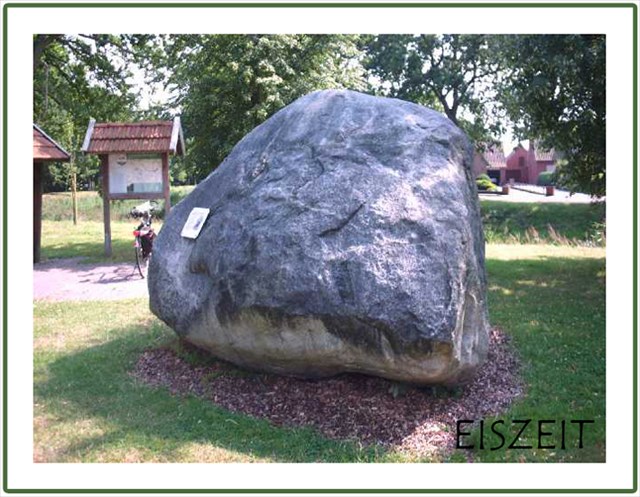
DEUTSCHE VERSION
Noch vor 20.000 Jahren sah es in Europa etwa so aus wie heute in Grönland: Der Boden war von einer dicken Eisschicht bedeckt, nur die Berge ragten heraus. Das Eis wurde durch sein eigenes Gewicht immer weiter nach Sueden gedrückt. Es schob dabei Sand, Geröll und große Felsbrocken mit sich.
Damals herrschte eine Eiszeit. Es war nur wenige Grad kälter als heute. Der Schnee jedoch, der im Winter fiel, schmolz im Sommer nicht mehr weg. Er wurde zu Eis, die Eisschichten zu Gletschern. An manchen Stellen war das Eis schließlich mehr als 3.000 Meter dick. Es gab bisher 4 Eiszeiten. Sie dauerten jedes Mal Tausende von Jahren. Sie wurden immer wieder durch lange Warmzeiten unterbrochen.
Woher weiß man das alles? Dazu waren viele Forschungen noetig. Einiges kann man an Zeugen der Eiszeit erkennen, z. B. dem "Grossen Stein von Georgsdorf".
Im Jahr 1982 wurde im Moor bei Georgsdorf ein riesiger Stein gefunden.
Dieser "Findling" ist 3,30 m hoch und wiegt 45 t. Er ist ungefähr so schwer wie 10 Elefanten.
Der Stein stammt aus Schweden, etwa daher, wo sich heute die Aland-Inseln in der Ostsee befinden. In der vorletzten Eiszeit wurde er durch den Druck der gewaltigen Eismassen nach Sueden verschoben. Diese Reise dauerte bestimmt Tausende von Jahren. Sie endete erst, als es wieder waermer wurde und das Eis schmolz. Man kann an dem Stein noch deutliche Schleifspuren sehen.
Um den Cache zu Loggen benoetigt Ihr:
1. (Optional) Ein Foto mit Euch und eurem GPS vor dem Findling als Anhang zu Eurem Log.
2. Den Umfang des Findlings in cm an seiner dicksten Stelle. (Schau auf das Schild) per Email an Bloodacker.
Viel Spass im wunderschoenen Georgsdorf wünscht Team Bloodacker
Quelle:http://www.gbiu.de/Lexikon/Geo/stein_geo.htm, http://gbiu.de/GB/01/Kreis/B/tour%20023.jpg
ENGLISH VERSION
Still before 20,000 years Europe looks like Greenland: The ground was from a thick ice sheet covered, only the mountains stood out. The ice was continued press by its own weight to the south. It pushed thereby sand, rubble and large large stones with itself. At that time an ice age prevailed. It was only few degrees colder than today. The snow however, which fell in the winter, did not melt away in the summer. It became ice, the ice sheets glaciers. In some places the ice was finally more than 3,000 meters thick. There were 4 ice ages. They lasted each thousands of years. They were interrupted again and again by long interglacial periods. From where does one know all this? In addition many research was necessary. One can recognize some by witnesses of the ice age, e.g. " Large stone of Georgsdorf". In the year 1982 in the moorland at Georgsdorf an enormous stone was found. This " Findling" is 3.30 m high and weigh 45 t. It is approximately as heavy as 10 elephants. The stone originates from Sweden, about from there where today the Aland islands are in the Baltic Sea. In the next to last ice age it was shifted with the pressure of the enormous ice masses to the south. This journey lasted determines thousands of years. It ended, when it became n more warmer and the ice meltet. Still you can see traces in the stone.
To log the cache you need:
1. (optional) A photo with you and your GPS in front of the Findling as appendix to your log.
2. The extent in cm of the Findling at its broadest place. (Answer to Bloodacker)
Have fun at beautiful Georgsdorf wishes team Bloodacker
Source: http://www.gbiu.de/Lexikon/Geo/stein_geo.htm